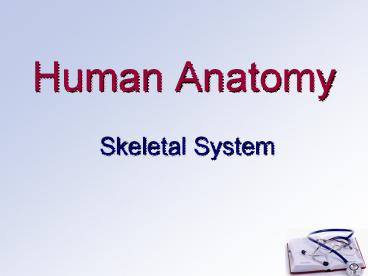Human%20Anatomy - PowerPoint PPT Presentation
Title:
Human%20Anatomy
Description:
Human Anatomy Skeletal System Functions Support: body structure and shape Protection for vital organs (brain, heart, etc.) Movement for attached skeletal muscles ... – PowerPoint PPT presentation
Number of Views:200
Avg rating:3.0/5.0
Title: Human%20Anatomy
1
Human Anatomy
- Skeletal System
2
Functions
- Support body structure and shape
- Protection for vital organs (brain, heart, etc.)
- Movement for attached skeletal muscles
- Tendons attach muscle to bone
- Ligaments attach bone to bone
- Mineral storage calcium and phosphorus
- Blood cell formation - hematopoiesis
3
Types of Bone
4
Compact Bone
- Very dense, stress bearing
- Haversian systems basic unit
- of compact bone
- Lamellae concentric cylinder
- shaped calcified structure
- Lacunae small spaces
containing tissue fluid - Osteocytes facilitate exchange
of calcium between blood and bone - Canaliculi canals connecting the lacunae
together and to the haversian canal which carries
nutrients and wastes to and from the osteocytes
5
Cancellous Bone
- Light, spongy
- Found at ends of long bones, ribs, sternum, hips,
vertebrae, cranium - No haversian systems
- Web-like arrangement
- Highly vascular
6
- Classification of Bones
7
Long bones
- Found in the extremities
- Act as levers
- Includes
- Epiphysis
- End of long bones
- Covered with hyaline cartilage for articulation
- Filled with cancellous bone
- Diaphysis
- Shaft
- Covered with periosteum
- Medullary canal
- Compact bone
- Examples femur, tibia, fibula, humerus,
- radius, clavicle, metacarpals, phalanges
8
Short Bones
- Cube shaped
- Allows flexible movement
- Cancellous bone covered by compact bone
- Examples
- Carpals
- Tarsals
9
Flat Bones
- Protect vital organs and provide broad surface
area for muscle attachment - Examples
- Cranial bones
- Scapula
- Sternum
- Ribs
10
Irregular Bones
- Peculiarly shaped to provide support and
protection, yet allow flexibility - Examples
- Vertebrae
- Ear
- Hyoid
- Mandible
11
Sesamoid Bones
- Extra bones found in certain tendons
- Example
- Patella
12
Composition
- Collagen chief organic constituent (protein)
- Inorganic calcium salts (Vitamin D essential for
absorption of minerals i.e. calcium) - Deposition favored by
- a. Estrogen, testosterone
- b. Alkaline phosphatase
- c. Thyrocalcitonin
- d. Mechanical stress i.e. traction
- Withdrawal favored by
- a. Alkaline phosphatase
- b. Parathormone
- c. Inactivity
13
Composition
- Cells
- Osteoblasts bone building, bone repairing cells
in the periosteum - Osteocytes mature bone cells within the bone
matrix - Osteoclast causes reabsorption of bone
- Periosteum
- 1. Dense, fibrous membrane covering bone
- 2. Contains blood vessels
- 3. Essential for bone cell survival and bone
formation
14
Cells that Aid in Bone Formation
Builds new bone
Osteoblast
Mature bone cell
Osteocyte
Osteoclast
Eats bone
15
Bone Formation
- Initially collagen fibers secreted by fibroblasts
- Cartilage deposited between fibers
- Skeleton fully formed by 2nd month of fetal
development (all cartilage) - After 8th week of fetal development ossification
(mineral matter deposited and replaces cartilage)
begins - Childhood and adolescence
- ossification exceeds bone loss
- Early adulthood thru middle age
- ossification equals bone loss
- After age 35
- bone loss exceed ossification
16
275 bones12 weeks (6-9 inches long)
Fetal Skeleton
17
Anatomy of Long Bone
- Diaphysis
- Shaft
- Composed of compact bone
- Epiphysis
- Ends of bone composed mostly
- of spongy bone
- Periosteum
- outside covering of diaphysis
- Endosteum
- Lines medullary cavity
- Arteries
- Articular cartilage
- Medullary cavity
- Cavity inside the shaft
- Contains yellow marrow (mostly fat) in adults
18
Bone Marrow
- Red bone marrow
- Found in vertebrae, ribs, sternum, cranium, ends
of humerus and femur - Produces
- Erythrocytes red blood cells
- Plateletes - thrombocytes clotting cells
- Some leukocytes white blood cells
- Yellow bone marrow
- Found in medullary cavity of long bones
- Fat storage
19
Bone Marrow
- Yellow marrow
- Medullary cavity of long bones
- Fat storage
- Red marrow
- Hematopoietic tissue
- In all cancellous bone in children
- In adults cancellous bone of vertebrae, hips,
sternum, ribs, cranial bones, proximal ends of
femur and humerus - Forms RBCs, platelets, some WBCs, and destroys
old RBCs and some foreign materials
20
Divisions of the Skeletal System
21
Axial Skeleton
- Forms the longitudinal axis of the body
- Divided into three parts
- Skull
- Vertebral Column
- Thorax
22
Appendicular Skeleton
- Composed of 126 bones
- Includes bones of the
- Limbs (appendages)
- Pectoral (shoulder) girdle
- Pelvic (hip) girdle
23
Joints
24
Classification
- Synarthrotic immovable - cranium
- Amphiarthrotic limited movement i.e. pubic
symphysis, vertebral joints, sacroiliac joint - Diarthrotic freely movable
- Gliding bones of the wrist
- Pivot between radius and ulna
- Ball and socket hip
- Hinge elbow
25
Immovable Joints Synarthrosis
26
Slightly Movable Joint Ampharthrosis
27
Freely Movable Diarthrosis
28
Synovial Joint Movement
Extension
Rotation
Flexion
Adduction
Abduction






























